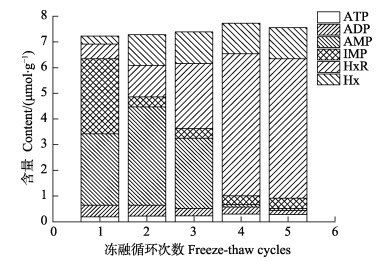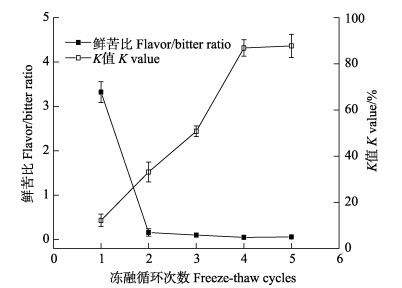2. 食品热加工工程中心 上海 201306;
3. 国家级食品科学与工程实验教学示范中心 上海 201306
2. Engineering Research Center of Food Thermal-Processing Technology, Shanghai 201306;
3. National Experimental Teaching Demonstration Center for Food Science and Engineering, Shanghai 201306
南极磷虾(Euphausia superba)被认为是一种丰富的蛋白质来源,总生物量估计为3.79亿t,其可利用生物量与人类目前捕获的其他水生生物的总生物量相当(Atkinson et al, 2009; 聂玉晨等, 2016)。南极磷虾作为食品进行开发利用面临一些问题,如外骨骼中高含量的氟化物对人体健康有潜在危害;另外,磷虾体内高活性的内源酶会引起死后的快速自溶,从而导致腐败(Anheller et al, 1989)。Boonsumrej等(2007)提出捕获后的磷虾应立即进行冷冻处理,以获得更好的品质。冷冻可以有效延缓磷虾的自溶,同时抑制微生物作用,在磷虾加工中得到了广泛的应用。
食品及其原料的冻融循环通常发生在零售场所、餐馆和家庭日常消费过程中(Ali et al, 2015)。在虾和其他水产品的冷冻贮藏过程中,脂质氧化、蛋白变性、冰晶的升华和重结晶,是引起品质变化的主要原因(Londahl, 1997; 曹荣等, 2016)。在解冻过程中,水产品原料的品质会进一步劣化,这主要取决于解冻方式、解冻速率和冻融次数(Srinivasan et al, 1998)。微波解冻比传统解冻更快速、更均匀,对组织的破坏更小,汁液损失更低,同时可以控制微生物的生长繁殖(郭洁玉, 2015),因而在食品工业和家庭消费中的应用越来越普遍。
反复冷冻和解冻会加速食品原料的品质劣化(Ali et al, 2015; 戚军, 2009)。如Sriket等(2007)发现冻融循环会加剧斑节对虾(Penaeus monodon)和凡纳滨对虾(Litopenaeus vannamei)蛋白质变性和肌纤维损伤。此外,冻融循环还会加剧对虾的脂质氧化和质构劣化(Boonsumrej et al, 2007)。目前,关于冷冻和微波解冻循环对南极磷虾风味影响的报道还很少。本研究通过分析南极磷虾虾肉糜在反复冷冻和解冻过程中ATP及其关联产物、游离氨基酸的变化,探究冻融循环对南极磷虾虾肉糜滋味成分的影响,为南极磷虾的高效加工利用提供参考。
1 材料与方法 1.1 实验材料冷冻的南极磷虾虾砖(250 g/块)购于山东青岛大康尚品商贸有限公司;三磷酸腺苷(Adenosine triphosphate, ATP)、二磷酸腺苷(Adenosine diphosphate, ADP)、腺苷酸(Adenosine monophosphate,AMP)、肌苷酸(Inosine monphosphate, IMP)、次黄嘌呤核苷(Hypoxanthine riboside, HxR)和次黄嘌呤(Hypoxanthine, Hx)标准品以及氨基酸标准品购于美国Sigma公司;甲醇、K2HPO4·3H2O、KH2PO4、NaOH、NaCl为色谱纯,其他试剂均为分析纯,购于国药集团化学试剂有限公司。
1.2 仪器与设备E2695高效液相色谱仪美国沃特世股份有限公司;L-8800氨基酸全自动分析仪日立(中国)有限公司;OSR-8微波工作站松下电器集团有限公司;Avanti J-26S高效离心机贝克曼库尔特商贸(中国)有限公司;FSH-2可调高速匀浆机常州国华电器有限公司。
1.3 实验方法 1.3.1 南极磷虾虾肉糜的制备南极磷虾虾砖常温条件下流水解冻30 min,去除表面多余的水分。取适量的南极磷虾放入研磨机中进行斩拌,每隔1 min斩拌1次,转速为10000 r/min,共斩拌3 min。将斩拌后的虾肉糜填入外径22 mm、内径20 mm、高15 mm的模具中,用封口膜密封。
1.3.2 冷冻和微波解冻处理将样品放于–20℃冰箱中冻藏7 d后取出解冻,再放入冰箱冻藏,重复5次,实验周期共35 d。样品从冰箱取出后,均在微波工作站中解冻。微波功率设置为150 W,解冻时通过光纤传感器来监测样品中心温度,样品中心温度达到(4±0.5)℃作为解冻终点。
1.3.3 ATP及其关联产物的分析参考贠三月等(2017)的方法并略作修改。准确称量5.0 g冻融循环后的虾肉糜样品,加入10% HClO4 20 ml,均质后在4℃条件下10000 r/min离心10 min,取上清液。在沉淀中继续加入5% HClO4 10 ml,重复上述操作。离心后将2次上清液合并,用KOH溶液调pH至5.8,定容到50 ml,用0.22 μm水相滤膜过滤后采用高效液相色谱仪进行分析。
高效液相色谱法的测试条件为:岛津ODS-3 C18柱(4.6 mm×250 mm,5 μm);柱温为30℃;流动相溶液A为KH2PO4和K2HPO4混合液,溶液B为甲醇;采用等梯度洗脱,流速为1.0 ml/min;进样量为10 μl;检测波长为254 nm。
1.3.4 鲜苦比的计算参考Zhang等(2018)的方法,计算公式如下:
| $ 鲜苦比(鲜味核苷酸和苦味核苷酸含量之比) = \frac{{{\rm{IMP}}}}{{{\rm{HxR + Hx}}}} $ |
式中,IMP、HxR和Hx为各呈味核苷酸含量(μmol/g)。
1.3.5 K值的计算参考Saito等(1959)的方法,计算公式如下:
| $ K值(\%) = \frac{{{\rm{HxR + Hx}}}}{{{\rm{ATP + ADP + AMP + IMP + HxR + Hx}}}} \times 100 $ |
式中,ATP、ADP、AMP、IMP、HxR和Hx为各核苷酸含量(μmol/g)。
1.3.6 游离氨基酸的测定参考王曜等(2014)的方法并略作修改。准确称量2.0 g冻融循环后的虾肉糜样品,加入0.02 mol/L的稀盐酸20 ml,均质5 min后,在4℃条件下5000 r/min离心10 min,取上清液定容至50 ml。取2 ml上述溶液加入50 ml离心管中,同时加入5%的磺基水杨酸2 ml,在4℃条件下10000 r/min离心10 min,取上清液经0.22 μm水相滤膜过滤后,进氨基酸全自动分析仪进行测定。
1.3.7 滋味活性值(TAV)的计算参考乔方等(2013)的方法,计算公式如下:
| $ {\rm{TAV = }}\frac{{滋味活性物质的浓度值}}{{该物质的味道阈值}} $ |
采用Origin 8.3绘制图表,显著性分析采用SPSS 21.0,结果采用平均值±标准差(Mean±SD)表示。
2 结果与讨论 2.1 南极磷虾虾肉糜在冻融过程中ATP及其关联产物变化图 1是冻融循环对南极磷虾虾肉糜ATP及其关联产物的影响。ATP的主要功能是为细胞提供能量(刘旭等, 2008; 汤水粉等, 2014)。水产动物死前挣扎程度、死后贮藏温度和条件等都会影响ATP的降解速度(Özogul et al, 2010)。ADP、AMP、IMP、HxR、Hx等都是ATP分解后的关联化合物。IMP是呈鲜味的核苷酸(Xi et al, 2016)。HxR和Hx可以产生苦味。1次冻融对应的AMP和IMP的含量相对较高,分别是2.79 μmol/g和2.92 μmol/g。在第2次冻融循环后,IMP含量显著下降(P < 0.05),从2.92 μmol/g下降至0.39 μmol/g,而AMP含量则增加至3.83 μmol/g。冻融循环3次后,IMP的含量无明显变化,AMP的含量则显著降低(P < 0.05)。HxR的含量随冻融次数呈现逐渐增加的趋势,在冻融循环4次后达到最大值5.53 μmol/g。冻融2次对应的Hx含量有明显增加,之后随冻融次数的增加变化不大。HxR和Hx的积累是自溶与微生物作用的结果(Pacheco-Aguilar et al, 2008)。

|
图 1 冻融循环对南极磷虾虾肉糜ATP及其关联产物的影响 Fig.1 Effects of freezing and thawing cycles on nucleotide related compounds of minced Antarctic krill |
鲜苦比可表征冻融循环对南极磷虾虾肉糜滋味的影响。由图 2可以看出,随着冻融次数的增加,呈苦味的核苷酸比例增大,1次冻融对应的鲜苦比为3.32,2次冻融对应的鲜苦比仅为0.16,差异极为显著(P < 0.01)。

|
图 2 冻融循环期间南极磷虾虾肉糜鲜苦比和K值的变化 Fig.2 Changes in flavor/bitter ratio and K value of minced Antarctic krill during freezing and thawing cycles |
K值是评价水产品新鲜度的常用指标。一般而言,K值越小表明水产品越新鲜(方艺达等, 2017)。刚捕获的水产品K值一般不超过10%,贮藏前期K值的增加主要是酶作用下ATP发生降解,随后K值的迅速增加则主要是微生物作用的结果(Morzel et al, 2003)。Saito等(1959)认为水产品K值< 20%表明非常新鲜,K值< 50%时可以接受,K值> 70%时表明已失去商品价值。图 2是冻融循环期间南极磷虾虾肉糜鲜苦比和K值的变化情况。随着冻融循环次数的增加,K值从12%增加到88%,4次冻融循环后南极磷虾已不新鲜,这主要是HxR含量增加的结果。Lee等(2016)发现冻融循环次数的增加,加速了氧化三甲胺脱甲基酶的释放和积累,加速了蛋白质的变性和聚集,由此导致鱼类肌肉的品质进一步劣化。
2.2 南极磷虾虾肉糜在冻融过程中游离氨基酸含量变化由表 1可知,南极磷虾虾肉糜中共检测到16种游离氨基酸,甘氨酸、丙氨酸、赖氨酸、精氨酸和脯氨酸含量相对较高。随着冻融次数的增加,虾肉糜中游离氨基酸的总含量逐渐增加,这与Zhou等(2011)的研究结果基本一致,这可能与冻融循环期间蛋白质持续发生降解有关(Mesias et al, 2016)。陈茜茜等(2014)发现冻融循环次数的增加促进了牛肉蛋白质的氧化与降解,降低了牛肉的嫩度和保水性。此外,冻融循环期间虾肉糜中游离氨基酸主要是甜味氨基酸和苦味氨基酸,鲜味氨基酸比例较低。随着冻融次数的增加,甜味氨基酸比例逐渐减小,而苦味氨基酸的比例有所增大。
|
|
表 1 冻融循环期间南极磷虾虾肉糜中游离氨基酸的含量 Tab.1 Free amino acids contents of minced Antarctic krill during freezing and thawing cycles (mg/g) |
TAV是单一的滋味活性物质的浓度与其阈值的比值,TAV > 1时,数值越大,对滋味的贡献越大(乔方等, 2013)。由表 2可知,冻融循环期间16种游离氨基酸中TAV值> 1的氨基酸有6种,分别为甘氨酸、丙氨酸、赖氨酸、组氨酸、精氨酸和脯氨酸。甘氨酸、丙氨酸和脯氨酸是呈甜味的氨基酸,赖氨酸、组氨酸和精氨酸是呈苦味的氨基酸(曹荣等, 2018)。在冻融循环期间,南极磷虾虾肉糜中3类呈味氨基酸的总TAV值大小顺序为:苦味 > 甜味 > 鲜味,说明虾肉糜中苦味氨基酸对滋味的贡献较大。
|
|
表 2 冻融循环期间南极磷虾虾肉糜中游离氨基酸的TAV值 Tab.2 Taste activity values of free amino acids in minced Antarctic krill during freezing and thawing cycles |
冻融循环对南极磷虾虾肉糜的滋味成分有显著的影响。随冻融循环次数的增加,ATP及其关联产物降解加剧,呈鲜味的核苷酸含量逐渐减少,呈苦味的核苷酸含量逐渐增加;甜味氨基酸比例逐渐减小,而苦味氨基酸的比例逐渐增大。因此,在工业化生产和家庭日常消费时,为了使南极磷虾虾肉糜保持较好的品质,应尽可能减少冻融循环次数,一般应控制在2次以内。
Atkinson A, Siegel V, Pakhomov EA, et al. A re-appraisal of the total biomass and annual production of Antarctic krill. Deep Sea Research Part I: Oceanographic Research Papers, 2009, 56(5): 727-740 DOI:10.1016/j.dsr.2008.12.007 |
Anheller JE, Hellgren L, Karlstam B, et al. Biochemical and biological profile of a new enzyme preparation from Antarctic krill (E. superba) suitable for debridement of ulcerative lesions. Archives of Dermatological Research, 1989, 281(2): 105-110 |
Ali S, Zhang WG, Rajput N, et al. Effect of multiple freeze-thaw cycles on the quality of chicken breast meat. Food Chemistry, 2015, 173(8): 808-814 |
Boonsumrej S, Chaiwanichsiri S, Tantratian S, et al. Effects of freezing and thawing on the quality changes of tiger shrimp (Penaeus monodon) frozen by air-blast and cryogenic freezing. Journal of Food Engineering, 2007, 80(1): 292-299 |
Chen QQ, Huang M, Zou YF, et al. Influence of irradiation and freeze-thawing cycles on myofibrillar protein oxidation and eating quality of beef. Food Science, 2014, 35(19): 1-5 [ 陈茜茜, 黄明, 邹玉峰, 等. 辐照和反复冻融对牛肉蛋白质氧化及食用品质的影响. 食品科学, 2014, 35(19): 1-5 DOI:10.7506/spkx1002-6630-201419001] |
Cao R, Wang FY, Zhao L, et al. Qualitative changes of squid (Loligo japonica) under different frozen storage temperatures. Progress in Fishery Sciences, 2016, 37(4): 97-103 [ 曹荣, 王凤玉, 赵玲, 等. 日本枪乌贼(Loligo japonica)不同温度冻藏过程中的品质变化. 渔业科学进展, 2016, 37(4): 97-103] |
Cao R, Zhao L, Sun HH, et al. Nutritional characteristics and umami assessment of Euphausia superba and Exopalaemon carinicauda. Food Science, 2018, 39(4): 149-153 [ 曹荣, 赵玲, 孙慧慧, 等. 南极磷虾(Euphausia superba)与脊尾白虾(Exopalaemon carinicauda)营养学特征分析及鲜味评价. 食品科学, 2018, 39(4): 149-153] |
Fang YD, Qiu XX, Chang SA, et al. Quality changes of shrimp (Litopenaeus vannamei) during chilled and ice storage. Meat Research, 2017, 31(7): 22-28 [ 方艺达, 裘肖霞, 常思盎, 等. 冷藏及冰藏条件下南美白对虾品质变化规律. 肉类研究, 2017, 31(7): 22-28] |
Guo JY. Radio frequency thawing process of frozen pork. Master′s Thesis of Jiangnan University, 2015 [郭洁玉.冻猪肉的射频解冻工艺.江南大学硕士研究生学位论文, 2015]
|
Londahl G. Technological aspects of freezing and glazing shrimp. INFOFISH International, 1997, 3: 49-56 |
Lee J, Fong Q, Park JW. Effect of pre-freezing treatments on the quality of Alaska pollock fillets subjected to freezing/ thawing. Food Bioscience, 2016, 16: 50-55 DOI:10.1016/j.fbio.2016.09.003 |
Liu X, Wang J, Zhang W, et al. Analysis of inosine monophosphate in six fish musculatures. Marine Sciences, 2008, 32(2): 22-24 [ 刘旭, 王军, 张纹, 等. 6种鱼类肌肉组织肌苷酸的检测分析. 海洋科学, 2008, 32(2): 22-24] |
Morzel M, van de Vis H. Effect of the slaughter method on the quality of raw and smoked eels (Anguilla anguilla L. ). Aquaculture Research, 2003, 34(1): 1-11 |
Mesias M, Wagner M, George S, et al. Impact of conventional sterilization and ohmic heating on the amino acid profile in vegetable baby foods. Innovative Food Science and Emerging Technologies, 2016, 34: 24-28 DOI:10.1016/j.ifset.2015.12.031 |
Nie YC, Zhang B, Zhao XY, et al. Seasonal variation in lipids and protein content of Antarctic krill (Euphausia superba). Progress in Fishery Sciences, 2016, 37(3): 1-8 [ 聂玉晨, 张波, 赵宪勇, 等. 南极磷虾(Euphausia superba)脂肪与蛋白含量的季节变化. 渔业科学进展, 2016, 37(3): 1-8] |
Özogul F, Özden Ö, Özoğul Y, et al. The effects of gamma-irradiation on the nucleotide degradation compounds in sea bass (Dicentrarchus labrax) stored in ice. Food Chemistry, 2010, 122(3): 789-794 DOI:10.1016/j.foodchem.2010.03.054 |
Pacheco-Aguilar R, Marquez-Ríos E, Lugo-Sánchez ME, et al. Postmortem changes in the adductor muscle of Pacific lions-paw scallop (Nodipecten subnodosus) during ice storage. Food Chemistry, 2008, 106(1): 253-259 |
Qiao F, Huang LL, Fang CF, et al. Analysis of taste-related compounds and electronic tongue of nuomici lychee fruits from different planting area. Food Research and Development, 2013, 34(16): 62-66 [ 乔方, 黄略略, 方长发, 等. 不同产区糯米糍荔枝的滋味物质及电子舌分析. 食品研究与开发, 2013, 34(16): 62-66 DOI:10.3969/j.issn.1005-6521.2013.16.018] |
Qi J. Effects of repeated freeze-thaw cycles on goat quality. Master′s Thesis of Nanjing Agricultural University, 2009 [戚军.反复冻融对羊肉品质的影响研究.南京农业大学硕士研究生学位论文, 2009]
|
Sriket P, Benjakul S, Visessanguan W, et al. Comparative studies on the effect of the freeze-thawing process on the physicochemical properties and microstructures of black tiger shrimp (Penaeus monodon) and white shrimp (Penaeus vannamei) muscle. Food Chemistry, 2007, 104(1): 113-121 |
Srinivasan S, Xiong YL, Blanchard SP, et al. Effects of freezing and thawing methods and storage time on physicochemical properties of freshwater prawns (Macrobrachium rosenbergii). Journal of Aquatic Food Product Technology, 1998, 7(2): 47-68 DOI:10.1300/J030v07n02_05 |
Saito T, Arai K, Matsuyoshi M. A new method for estimating the freshness of fish. Bulletin of the Japanese Society of Scientific Fisheries, 1959, 24(9): 749-750 DOI:10.2331/suisan.24.749 |
Tang SF, Qian ZZ, Luo FF, et al. Determination of ATP-related compounds in aquatic products by high performance liquid chromatography. Progress in Fishery Sciences, 2014, 35(2): 110-116 [ 汤水粉, 钱卓真, 罗方方, 等. 高效液相色谱法测定水产品中ATP关联化合物. 渔业科学进展, 2014, 35(2): 110-116 DOI:10.3969/j.issn.1000-7075.2014.02.016] |
Wang Y, Chen SS. Comparative composition of free amino acids in wild and cultured Procambarus clarkii. Food Science, 2014, 35(11): 269-273 [ 王曜, 陈舜胜. 野生与养殖克氏原螯虾游离氨基酸的组成及比较研究. 食品科学, 2014, 35(11): 269-273 DOI:10.7506/spkx1002-6630-201411054] |
Xi F, Sun HM, Lee HY, et al. Effect of irradiation on the degradation of nucleotides in turkey meat. LWT-Food Science and Technology, 2016, 73: 88-94 DOI:10.1016/j.lwt.2016.05.040 |
Yun SY, Qiu WQ, Jiang CY, et al. Comparison of flavor compounds in meat and head of Litopenaeus vannamei. Journal of Fisheries of China, 2017, 41(6): 907-918 [ 贠三月, 邱伟强, 蒋晨毓, 等. 凡纳滨对虾虾肉和虾头中风味物质的比较. 水产学报, 2017, 41(6): 907-918] |
Zhou M, Wang AL, Xian JA. Variation of free amino acid and carbohydrate concentrations in white shrimp, Litopenaeus vannamei: Effects of continuous cold stress. Aquaculture, 2011, 317(1): 182-186 |
Zhang RJ, Qiu WQ, Zhang MS, et al. Effects of different heating methods on the contents of nucleotides and related compounds in minced Pacific white shrimp and Antarctic krill. LWT-Food Science and Technology, 2018, 87: 142-150 DOI:10.1016/j.lwt.2017.08.078 |



